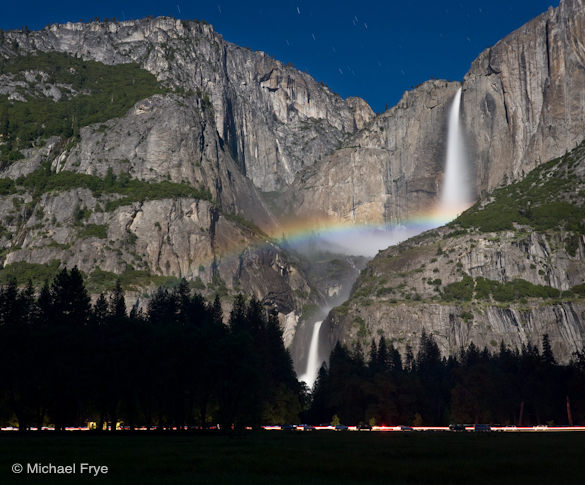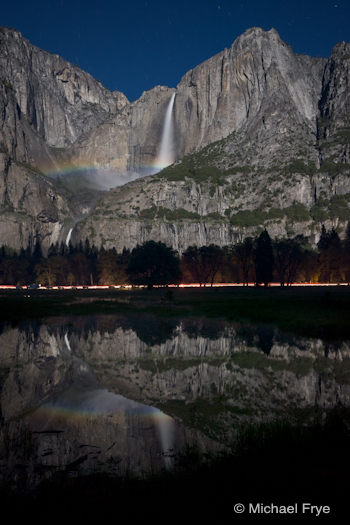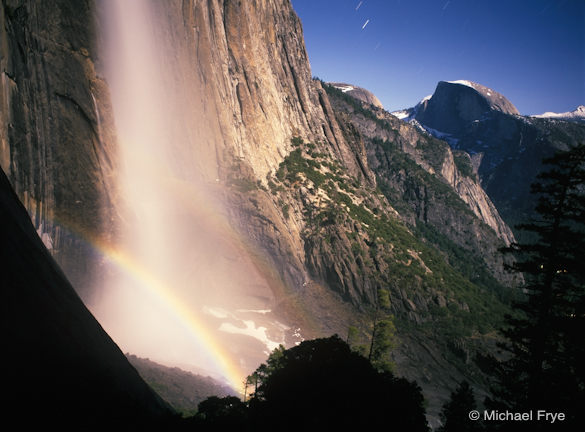by Michael Frye | Jun 15, 2011 | Yosemite Photo Conditions

Abundant mist created an exceptionally wide lunar rainbow on Upper Yosemite Fall last night.
The National Park Service announced today that Tioga Pass will open this Saturday at 8 a.m. Last year the high country still held tons of snow on opening day, and it was wintry and beautiful. It sounds like there’s even more snow this year, and I’m looking forward to seeing it!
Meanwhile, the warmest temperatures of the year have created minor flooding in Yosemite Valley. The highest water levels are expected tomorrow morning, and Swinging Bridge will probably be underwater. Some road closures are possible, and some campsites may be evacuated (perhaps already have?), but it looks like there won’t be any major closures in the near future. However, there’s still plenty of snow at higher elevations, and hot weather is expected to return in the middle of next week, so it seems likely that we’ll see more minor flooding by next Wednesday or Thursday.
(more…)
by Michael Frye | May 11, 2011 | Advanced Techniques, Yosemite Photo Conditions

Lunar rainbow on Upper Yosemite Fall from Cook’s Meadow, May 2009
A full moon is coming up—Tuesday, May 17th, at 4:08 a.m. There should be plenty of spray in Yosemite Falls, so once again it should be possible to photograph a lunar rainbow, and I expect that many photographers will be in Yosemite trying to do just that. If you’re one of those people, last year I wrote some lunar rainbow photography tips that you might find helpful.
To learn the best times for photographing the moonbow, visit Don Olson’s web site. Good luck!
by Michael Frye | Apr 25, 2010 | Advanced Techniques, Photography Tips
Half Dome and Upper Yosemite Fall with a lunar rainbow
In Friday’s post on my other blog I described some of my experiences attempting to photograph lunar rainbows, but here are some tips for capturing your own moonbow images.
The moon will become full at 5:19 Wednesday morning, so Tuesday night will provide the brightest moonlight, and the best chance to photograph a lunar rainbow this month—if the weather cooperates. Unfortunately the forecast calls for rain. If the predictions are faulty, and some moonlight manages to break through the clouds, cool temperatures will probably limit the amount of spray on Upper Yosemite Fall, so Lower Yosemite Fall may work better. For the upper fall, you might be better off waiting for the next full moon on May 27th. For detailed information on times and places to photograph lunar rainbows in Yosemite, see Don Olson’s site.
For those who aspire to capture lunar rainbows, here are some tips.
Equipment
Any digital SLR will work, but full-frame sensors usually produce less noise and work better for the long exposures required at night. A sturdy tripod is essential, plus a locking cable release or electronic release. You’ll want a good flashlight or headlamp, a watch to time long exposures, and a cloth for wiping spray off the lens if you’re at the lower fall. Long exposures drain batteries quickly, so make sure your camera battery is fully charged—and your spare too.
Focus and Depth of Field
To make exposure times reasonably short, you’ll have to keep your aperture wide open, or close to it. That means you won’t get much depth of field, so try to exclude foregrounds from your compositions. This shallow depth of field makes focusing critical. It’s obviously difficult to focus manually in the dark, and autofocus won’t work either. In the past I’d just manually set the lens at infinity, but many lenses now focus past infinity, making the correct focusing point difficult to determine. The solution is to find something distant that’s bright enough to focus on, like the moon itself, car headlights, or perhaps a bright light that you place far away. Then focus on that bright spot, using either manual or autofocus. The most precise method is probably focusing manually during a zoomed-in look in live view. Once you’ve set the focus, turn autofocus off and don’t touch the focusing ring—leave the lens set at this distance for all your images. You might even tape the focusing ring so it doesn’t move. (more…)
by Michael Frye | May 9, 2009 | Photography Tips, Yosemite Photo Conditions
 Last night I joined the throngs in Cook’s Meadow to photograph the lunar rainbow on Upper Yosemite Fall. There were at least 100 photographers around the meadow, and probably many more at the bridge below Lower Yosemite Fall. Like Horsetail Fall in February, lunar rainbows have become a photographic phenomenon. Until recently the most popular place was at Lower Yosemite Fall, but since Don Olson published specific times for seeing the “moonbow” from the Sentinel Bridge in Cook’s Meadow this spot has attracted lots of photographers. The big advantage is that it’s dry! At the bridge below Lower Yosemite Fall it’s impossible to keep mist off the front of the lens.
Last night I joined the throngs in Cook’s Meadow to photograph the lunar rainbow on Upper Yosemite Fall. There were at least 100 photographers around the meadow, and probably many more at the bridge below Lower Yosemite Fall. Like Horsetail Fall in February, lunar rainbows have become a photographic phenomenon. Until recently the most popular place was at Lower Yosemite Fall, but since Don Olson published specific times for seeing the “moonbow” from the Sentinel Bridge in Cook’s Meadow this spot has attracted lots of photographers. The big advantage is that it’s dry! At the bridge below Lower Yosemite Fall it’s impossible to keep mist off the front of the lens.
You can’t really see a lunar rainbow with the naked eye. Our eyes don’t render color very well in the dark, so at best you can see a bright arc and maybe a hint of color. But the color is there, and film or digital sensors capture it well. One of the reasons that more people haven’t photographed lunar rainbows from Cook’s Meadow in the past is that you can’t really see it from there. With film you’d just have to guess about the position and wait to find out whether you were right. With digital sensors it’s easy to just take a photo and see the position of the rainbow.
Last night the moon was bright enough that I could see the rainbow fairly well. Along with everyone else I watched it move down the fall as the moon rose. When the rainbow fell too low, most people packed up (it was 11:30 p.m. after all), but I followed the moon westward and saw an even more vivid rainbow from near the Yosemite Chapel. This photograph was made from that spot. Rainbows form a circle around a spot opposite the light source—sun or moon. Lunar rainbows can be seen on any waterfall that gets moonlight if you position yourself properly. In fact I photographed a lunar rainbow on Castle Geyser in Yellowstone many years ago. Maybe I’ll put that image in another post.
Long exposures with digital cameras can create lots of noise, but newer models handle this pretty well. You’re usually better off making a long exposure at a low ISO than a shorter exposure with a higher ISO. But with lunar rainbows you don’t want to make the exposure too long or the bands of color will blend together. I used a six-minute exposure at f/4 and 100 ISO for the image above. Trying to lighten a dark image will exaggerate noise, so it’s best to make the photograph as light as possible without overexposing it. Don’t rely on just how it looks on your LCD screen. Since it’s dark, the screen will look bright even if the image is underexposed. Use your histogram.
Having said that, a nighttime photograph shouldn’t be too bright. You don’t want it to look like it was taken under midday sunlight. I actually darkened this image—especially the sky—in software to give it more of a nighttime feeling.












